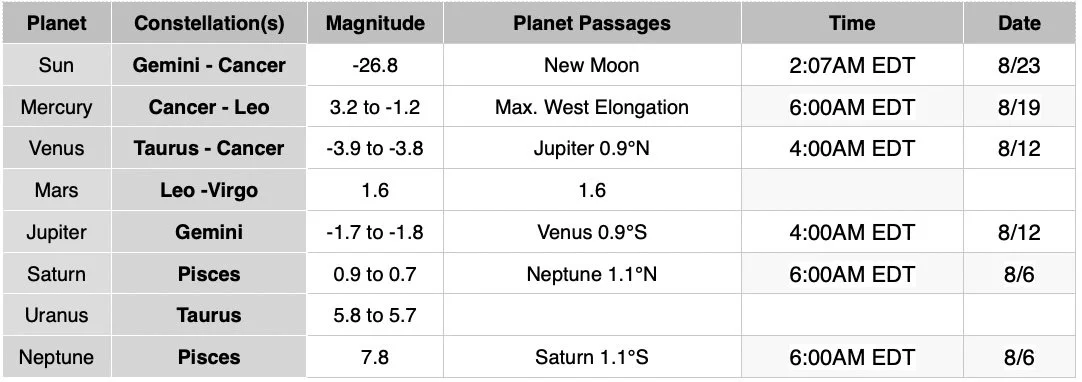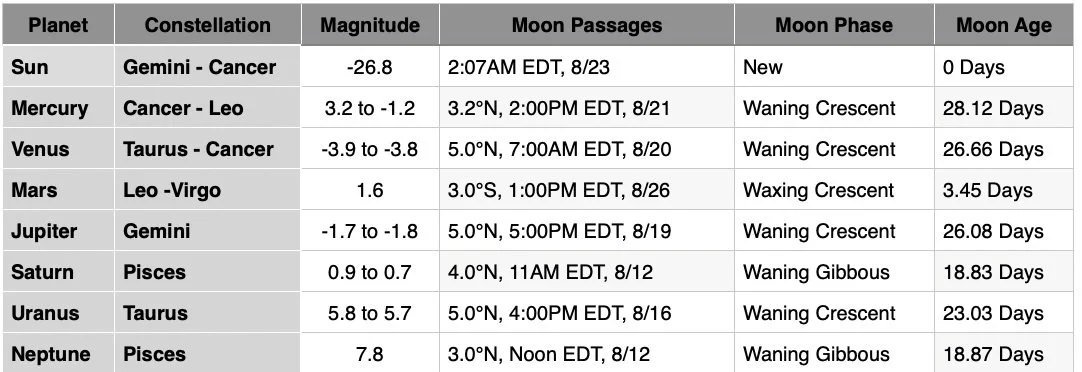August 2025 skies
BY: DICK COOKMAN & Elias Russell
🚀 Highlights: Comet Journal, Martian Landers, Meteor Showers, Planet Plotting, August Moon.
Focus Constellations: Perseus, Cassiopeia, Cepheus, Draco, Ursa Minor, Ursa Major, Bootes, Corona Borealis, Hercules, Lyra, Cygnus, Pegasus, Equuleus, Delphinus, Aquila, Ophiuchus
☄️Comets – Space Visitors on the Move
August is a quiet month for comets. The famous Comet Tsuchinshan–ATLAS (C/2023 A3), which wowed astronomers earlier this year, is fading as it heads back into the far reaches of the solar system.
Another icy traveler, Comet 12P/Pons-Brooks, is slowly drifting closer to the Sun but won’t be bright enough to see yet. Translation: no big “wow” comets this month but telescopes and big binoculars might still catch a faint glimpse.
Think of August as the calm before the next comet storm. Some brighter comets are expected in late 2025 and 2026, so we’re just waiting for the next cosmic showstopper.
Comet C/2023 A3 (Tsuchinshan-ATLAS) is on the Lyra/Hercules border and at 13th magnitude. It is departing to the Oort Belt or, if its orbit is hyperbolic and allows escape from the Sun, the great beyond.
First discovered in May, C/2025 K1 (ATLAS) is a 12th magnitude Oort Belt comet rising in Pegasus in the evening and moving into Vulpecula in July. Perihelion passage is on October 8 in Virgo when it may reach 8th magnitude. It is closest to Earth in late November.
🚀 Mars – What are the Rovers Up To? Our robot explorers are still hard at work on Mars.
Perseverance is cruising across Jezero Crater, drilling rocks that might someday come back to Earth to tell us if Mars was once full of life.
Curiosity (the “old-timer” rover that landed in 2012) is still climbing Mount Sharp and studying ancient lake beds.
It might sound bland, but every scoop of dirt, every photo, and every drilled rock gets us closer to knowing if Mars could have been Earth’s twin long ago.
🌟 Meteor Showers – The Perseids Are Here!
This is the month for shooting stars. The Perseid meteor shower peaks on August 12–13, and it’s one of the most reliable and spectacular meteor shows of the year.
🔭 How to watch: Find a dark spot away from streetlights, let your eyes adjust for 20 minutes, and look up after midnight. You might see 50–70 meteors an hour with some will leave long, glowing trails across the sky. This year the moon sets before the best hours, which means darker skies and a better show. Bring a blanket, a friend, and maybe some hot chocolate 😋 it’s going to be a great night for skywatching.
🪐Planet Plottings
Mars (1.6) in Virgo sets three hours after the Sun, while Saturn (0.9 to 0.7) and Neptune (7.8) rise in Pisces about a half hour later around midnight and can be seen throughout the rest of the night. Mars is visible throughout the entire month and sets about two hours after sunset at month’s end as the waxing crescent Moon passes on the 26th, 3 days after New Moon. Saturn (0.9 to 0.7), and Neptune (7.8) can be found about 1° apart on the 6th. The waning gibbous Moon passes Neptune and Saturn on the 12th.
Uranus (5.8 to 5.7) rises in Taurus an hour after midnight and will be visited by the waning crescent Moon on the 16th. Venus (-4.0 to -3.9) in Taurus is next, rising at 3:00 AM EDT, about 45 minutes before Jupiter (-1.7 to -1.8) makes its appearance in Gemini. Brilliant Venus closes in on Jupiter in August, moving into Gemini before making a close encounter with the king of the planets on the 12th when they are less than 1° degree apart. Venus sails on by to rise about an hour after Jupiter by the end of the month. The waning crescent Moon passes Jupiter on the 19th and Venus on the 20th.
Mercury (3.2 to -1.2) moves through Cancer and into Leo and can be seen in the eastern sky slightly before sunrise. Mercury is at greatest western elongation on the 19th when it is 19° from the Sun. The waxing crescent Moon passes Mercury on the 21st.
🌚August Moon
August’s New Moon in Leo on the 23rd at 2:07AM EDT introduces Lunation 1270 which ends 29.57 days later with the New Moon of September 21 at 3:53PM EDT. The Full Moon on the 9th at 3:55AM EDT is in Capricornus, 50° (2 outstretched hands-pinky to pinky) south of Cygnus, and is the Grain, or Green Corn Moon. Colonial Americans called it “Dog Day’s Moon”. To the Celts it was “Dispute Moon”, and it is “Harvest Moon” in China. Medieval English thought of it as “Corn Moon” and to some Anishinaabe (Odawa, Potawatomi, and Ojibwe) people, it is Manoominike-giizis (Ricing Moon).
In the play “Teahouse of the August Moon”, some view the stereotypes of Asian people to be offensive. But the 1953 movie contrasts our modern rigid, materialistic worldview with viewpoints shared by indigenous and other people of Okinawa, the Americas, and elsewhere. For them, the August moon symbolizes a connection with nature and tradition, and a time for harvest and reflection. Nanaboujou, the heroic Anishinaabe Protecting Spirit/Trickster, and Ajijaak, the Whooping or Sandhill Crane, mark the Milky Way in the southern evening sky in August. Nanaboujou plays a significant role in creation of Turtle Island (North America) and its inhabitants in Anishinaabe stories and is in the southwest evening sky in Scorpius, setting before midnight and hosts the Moon on the 4th and 31st. Ajijaak, in Cygnus, rises before sunset and sets after sunrise. He wisely communicates and leads, restoring balance and reciprocity, and rejuvenating environments shaped by Nanaboujou. The Kanawayhitowin website presents cultural teachings of the Mississauga branch of the Anishinabek Nation including the cycle of life and nature of the 13 Grandmother Moons. To many Ontario Anishinaabe, “The eighth moon of Creation is the Thimbleberry Moon, when we honour the Thimbleberry which produces an abundance of fruit once every three years. It was one of the first plants put on Mother Earth, and its purpose is to protect the Sacred Circle of Life by allowing us to recognize and understand the teachings that come from the Spirit World.”

